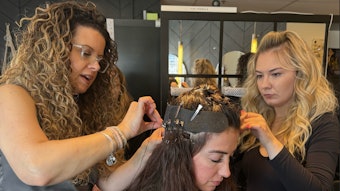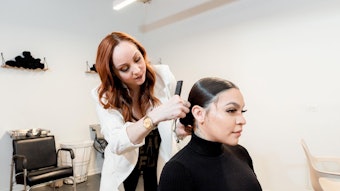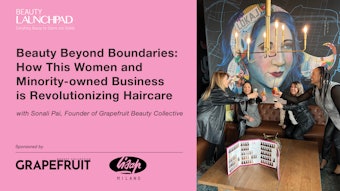
May is Mental Health Awareness Month, a time to raise awareness of those living with mental or behavioral health issues and help reduce the stigma so many experience.
For stylists who have so much on their plate and often serve as an outlet to their clients to discuss the daily on-goings of their life, mental health is a priority that often gets overlooked.
“As a service provider or leader, you cannot pour from an empty cup,” shares Kelly Cahen (@scissorsmakecents), salon owner and business coach. “It is imperative that beauty professionals have an outlet or modality to help release all that we absorb daily in our practice of serving others.”
After realizing the importance of prioritizing her mental health, Elizabeth Faye (@heyelizabethfaye) – a now certified business/trauma informed life coach – made a pivot in her career path to help provide wellness solutions for the beauty industry.
“What really changed my career path to what I do now was I got burned out. I was so sick physically that I couldn't do anything, and I didn't know what was wrong with me. It was a serious health crisis physically,” Faye shares. “I realized how it changed my life so quickly and so fast that it ended up becoming my study and my profession for the beauty industry. If you do not prioritize these things, your body will make you prioritize them.”
Sarai Speer (@theplatinumgiraffe), a hairstylist empowerment coach and meditation and yoga teacher, experienced a similar mental health crisis, falling victim to hustle culture for seven years, which led to a two-year burnout.
“Prioritizing my mental health and well-being was a game-changer. It allowed me to recharge and show up as my best self for my clients and my business,” says Speer.
Now, these three beauty pros are sharing their insight, tips and advice for those who are looking to make changes at how they address mental health in the hair and beauty industry.
Prioritizing Mental Health in the Beauty Industry
Whether it’s a full book of clients, a social media presence to develop, collaborations with brands, running a salon or any other task, there’s never a slow moment in the hair industry. As a stylist, you have to take steps on your own to prioritize your mental health, but it’s crucial that the industry has measures and values in place to care for its professionals.
So, how does the hair industry stack up? Our pros all agree that the industry is moving in the right direction, but there’s still a long road ahead to make meaningful progress.
“Jokes about skipping meals, being so booked you can’t see straight and no days off are becoming less common, but they still exist,” Speer says.
Faye agrees. “I think a lot of our old cultural, systematic things or stigmas have been changing and crumbling, and people are trying to do better,” she explains. She continues that with the correct tools and resources, the industry would be better equipped to address the mental health needs of its stylists.
“As a whole, I do believe that the industry is shifting in the right direction of providing education and resources to beauty pros,” Cahen adds. “The awareness brought to mental health has been an incredible step in supporting us as service providers in a people focused business. I also believe there is still work to be done on the smaller scale with some owners (and stylists) being able to be self aware and learn ways to coach teams to success without toxicity.”
Making Changes
Faye shares that beauty professionals are often placed in the role of a therapist without being asked, and that they don’t have the tools to handle carrying the weight of their client’s burdens as well as their own. On top of all the other hats stylists wear in the industry, it’s no surprise that burnout is a common issue, with a survey by L’Oréal Professionnel Paris in 2023 finding that 65 percent of hairstylists have experienced anxiety, burnout or depression during their professional career.
So, how can the industry change the way it approaches addressing the mental health needs of its professionals?
“Having tools for nervous system regulation, mindfulness, conscious communication, conflict resolution and leadership skills can help protect our own energy, health and vitality long term,” Faye explains.
Cahen believes the best place to start introducing these tools is during cosmetology school.
“We are so technically driven from the start, which is extremely important, but we also leave out very crucial information that is needed when working with people on a regular and consistent basis,” Cahen shares. “As an owner of a salon, I dedicate at least 2-4 self improvement experiences a year for my team along with technical education. I believe we need to focus on the full person, not just the artist.”
Speer believes that an entire culture shift is needed to empower stylists to put their mental health first.
“This means openly communicating our needs and setting boundaries without fear of judgment,” Speer explains. “Salon owners should actively support this by fostering open communication and creating flexible work environments. Industry publications can play a big role too, by featuring more content from stylists leading the mental health movement and normalizing self-care practices. Ultimately, we need safe spaces for stylists to talk openly about their struggles without judgment. This will empower everyone to prioritize well-being and create a healthier work environment for all.”
Putting Practices in Place
Change can be overwhelming, and it’s oftentimes difficult to know where to start or what the best practices are to put into place to make a meaningful and impactful shift in your salon environment.
Speer recommends six things salon owners should and can do to create an environment that supports the mental health needs of its stylists:
- Open communication: Start by normalizing conversations about mental health. Encourage stylists to openly discuss their needs and challenges.
- Flexible scheduling: Offer flexible work schedules or options for part-time work to prevent burnout.
- Benefits: Consider offering mental health benefits as part of your employee package. This could include access to therapy sessions or Employee Assistance Programs (EAPs).
- Encourage breaks: Discourage the mentality of skipping breaks. Ensure stylists have dedicated breaks throughout the day to recharge.
- Create a relaxing space: Designate a break room or area for stylists to unwind during breaks, with comfortable seating and calming décor.
- Lead by example: Take breaks yourself and prioritize your own well-being. This shows stylists it's okay to do the same.
Cahen adds that mental health days should be included in time-off policies, saying, “Allowing your teams to take time off when they need it regardless of physical sickness or not, shows that you prioritize both.
Faye and Cahen also encourage having regular meetings and check-ins with your team, so there’s always an open window for communication and support.
Taking Initiative
While it’s important and crucial to have an environment that is supportive of its professionals mental health needs, none of that matters if you aren’t taking steps on your own to care for your mental health. Speaking from experience, it’s easy to skip a meal so you can finish a task, work long hours to fit in as many tasks as possible into the day and even wreck your sleep schedule just to see how much more you can get done.
So how do you break those bad habits and damaging cycles of behavior?
Sarai shares her to-go tips:
- Set boundaries: Don't be afraid to communicate your needs to clients and colleagues. This could involve setting clear scheduling limitations or taking breaks throughout the day.
- Prioritize self-care: Schedule time for activities that recharge you, whether it's exercise, hobbies, spending time with loved ones or simply getting enough sleep.
- Recognize warning signs: Be mindful of signs of burnout, such as fatigue, cynicism or difficulty concentrating. If you experience these, address them early on.
- Seek professional help: Therapy can be a valuable tool to manage stress, develop coping mechanisms and improve overall well-being.
- Having a support system is a game-changer. This could be an online community of stylists, your salon colleagues or even a therapist. Don't underestimate the power of a safe space to talk openly and be yourself without judgment.
- Create your non-negotiables. For me, that means a morning routine and yoga. These practices are essential to my well-being, and I know I'm more reactive than responsive when I skip them.
- Find your passions outside of hair. When I was constantly hustling, my world revolved around hair and social media. It left me feeling empty. Now, I make sure to nurture hobbies and interests that fill my cup and remind me of life beyond the salon.
When it comes to setting your schedule in the salon, Cohen advises the following: “My advice would be to pre plan out your schedules at least a quarter in advance if not the full year. It’s important to block time for important appointments, vacation times and rest days that are truly meant to prioritize self. Setting boundaries (and keeping them) at work and in personal relationships is one of the healthiest things a person can do for themselves.”
Mental Health Resources for the Beauty Professional
When you are at your lowest and your cup is at its emptiest, it’s difficult to even think about taking the first step, especially on your own. That’s why having the proper mental health tools and resources at your disposal is crucial.
Cohen recommends keeping a journal and asking yourself three key questions each day:
- What am I feeling today?
- Why am I feeling this way?
- What do I need today?
“Checking in with yourself every day helps you to identify what needs help before it becomes unmanageable. Sometimes, there may be a true need that signals finding help or support, and other times you can simply celebrate what is going right,” she shares.
Faye is soon set to launch the Vitality Project, a first of its kind project that is bridging the gap between the human and the craft. The project will teach leadership skills, trauma-informed communication skills, conflict resolution skills and other self-care tools.
“We know that human vitality is business vitality,” Faye shares. “I think being able to have a culture that prioritizes vitality – whether that be integrating vacation time, play, a healthy work schedule, flexibility, a culture where people eat and sit down in the back, a moment of mindfulness, maybe a sacred space where people can relax and decompress and that everyone takes care of themselves outside of the salon – is what we want to teach people.”
Here are some additional resources for you or your salon staff, if someone is struggling or needs extra help:
- Mental Health America
- National Institute of Mental Health
- Anxiety and Depression Association of America
- Mental Health First Aid
- The Sanctuary Challenge
- IDONTMIND
About Our Experts:
Elizabeth Faye (@heyelizabethfaye) is a certified business/trauma informed life coach for beauty industry entrepreneurs, educators and brands. She has over 10 years of experience and has served thousands of entrepreneurs and over 20 organizations.
Sarai Speer (@theplatinumgiraffe) is an empowerment coach and creator of the Balanced Stylist Society. She is committed to empowering stylists and creative entrepreneurs to find their power, overcome self limiting beliefs, achieve their goals with a holistic approach.
Kelly Cahen (@scissorsmakecents) is the Founder and CEO of Scissors Make Cents, a one-of-a-kind education experience that combines entertaining stories of personal experience and encouragement with tasks and accountability for stylists or salon owners who are looking to build a rock solid brand.











